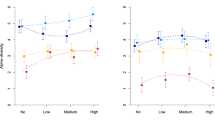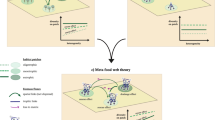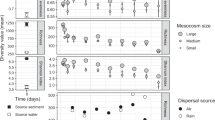Abstract
Theory and small-scale experiments predict that biodiversity losses can decrease the magnitude and stability of ecosystem services such as production and nutrient cycling1,2. Most of this research, however, has been isolated from the immigration and emigration (dispersal) processes that create and maintain diversity in nature3,4,5. As common anthropogenic drivers of biodiversity change—such as habitat fragmentation, species introductions and climate change—are mediated by these understudied processes5,6,7, it is unclear how environmental degradation will affect ecosystem services3,4. Here we tested the interactive effects of mobile grazer diversity and dispersal on the magnitude and stability of ecosystem properties in experimental seagrass communities that were either isolated or connected by dispersal corridors. We show that, contrary to theoretical predictions2,8,9,10,11, increasing the number of mobile grazer species in these metacommunities increased the spatial and temporal variability of primary and secondary production. Moreover, allowing grazers to move among and select patches reduced diversity effects on production. Finally, effects of diversity on stability differed qualitatively between patch and metacommunity scales. Our results indicate that declining biodiversity and habitat fragmentation synergistically influence the predictability of ecosystem functioning.
This is a preview of subscription content, access via your institution
Access options
Subscribe to this journal
Receive 51 print issues and online access
$199.00 per year
only $3.90 per issue
Buy this article
- Purchase on Springer Link
- Instant access to full article PDF
Prices may be subject to local taxes which are calculated during checkout



Similar content being viewed by others
References
Hooper, D. U. et al. Effects of biodiversity on ecosystem functioning: A consensus of current knowledge. Ecol. Monogr. 75, 3–35 (2005)
Cottingham, K. L., Brown, B. L. & Lennon, J. T. Biodiversity may regulate the temporal variability of ecological systems. Ecol. Lett. 4, 72–85 (2001)
Giller, P. et al. Biodiversity effects on ecosystem functioning: Emerging issues and their experimental test in aquatic environments. Oikos 104, 423–436 (2004)
Srivastava, D. S. & Vellend, M. Biodiversity–ecosystem function research: Is it relevant to conservation? Annu. Rev. Ecol. Evol. Syst. 36, 267–294 (2005)
Gonzalez, A. & Chaneton, E. J. Heterotroph species extinction, abundance and biomass dynamics in an experimentally fragmented microecosystem. J. Anim. Ecol. 71, 594–602 (2002)
Sala, O. E. et al. Global biodiversity scenarios for the year 2100. Science 287, 1770–1774 (2000)
Peterson, A. T. et al. Future projections for Mexican faunas under global climate change scenarios. Nature 416, 626–629 (2002)
Doak, D. F. et al. The statistical inevitability of stability–diversity relationships in community ecology. Am. Nat. 151, 264–276 (1998)
Tilman, D. The ecological consequences of changes in biodiversity: A search for general principles. The Robert H. MacArthur award lecture. Ecology 80, 1455–1474 (1999)
Yachi, S. & Loreau, M. Biodiversity and ecosystem productivity in a fluctuating environment: The insurance hypothesis. Proc. Natl Acad. Sci. USA 96, 1463–1468 (1999)
Fukami, T., Naeem, S. & Wardle, D. A. On similarity among local communities in biodiversity experiments. Oikos 95, 340–348 (2001)
Whittaker, R. H. Evolution and measurement of species diversity. Taxon 21, 213–251 (1972)
Bond, E. M. & Chase, J. M. Biodiversity and ecosystem functioning at local and regional spatial scales. Ecol. Lett. 5, 467–470 (2002)
Chase, J. M. & Ryberg, W. A. Connectivity, scale-dependence, and the productivity–diversity relationship. Ecol. Lett. 7, 676–683 (2004)
Loreau, M., Mouquet, N. & Gonzalez, A. Biodiversity as spatial insurance in heterogeneous landscapes. Proc. Natl Acad. Sci. USA 100, 12765–12770 (2003)
Cardinale, B. J., Ives, A. R. & Inchausti, P. The effect of species diversity on ecosystem productivity: Extending our spatial and temporal scales of inference. Oikos 104, 437–450 (2004)
Mouquet, N. & Loreau, M. Community patterns in source-sink metacommunities. Am. Nat. 162, 544–557 (2003)
Fukami, T. Community assembly along a species pool gradient: Implications for multiple-scale patterns of species diversity. Popul. Ecol. 46, 137–147 (2004)
Thébault, E. & Loreau, M. Trophic interactions and the relationship between species diversity and ecosystem stability. Am. Nat. 166, E95–E114 (2005)
Cadotte, M. W. & Fukami, T. Dispersal, spatial scale, and species diversity in a hierarchically structured experimental landscape. Ecol. Lett. 8, 548–557 (2005)
Forbes, A. & Chase, J. M. The role of habitat connectivity and landscape geometry in experimental zooplankton metacommunities. Oikos 96, 433–440 (2002)
Adler, P. B., Raff, D. A. & Lauenroth, W. K. The effect of grazing on the spatial heterogeneity of vegetation. Oecologia 128, 465–479 (2001)
Morin, P. J. & McGrady-Steed, J. Biodiversity and ecosystem functioning in aquatic microbial systems: A new analysis of temporal variation and diversity-predictability relations. Oikos 104, 458–466 (2004)
Naeem, S. & Li, S. Biodiversity enhances ecosystem reliability. Nature 390, 507–509 (1997)
McCann, K. S., Rasmussen, J. B. & Umbanhowar, J. The dynamics of spatially coupled food webs. Ecol. Lett. 8, 513–523 (2005)
Resetarits, W. J. Jr, Binckley, C. A. & Chalcraft, D. R. in Metacommunities: Spatial Dynamics and Ecological Communities (eds Holyoak, M., Leibold, M. A. & Holt, R. D.) (Chicago Univ. Press, Chicago, 2005)
Larkum, A. W. D., Orth, R. J. & Duarte, C. (eds) Seagrasses: Biology, Ecology and Conservation (Springer, Amsterdam, 2006)
Duffy, J. E., Richardson, J. P. & Canuel, E. A. Grazer diversity effects on ecosystem functioning in seagrass beds. Ecol. Lett. 6, 637–645 (2003)
France, K. E. & Duffy, J. E. Consumer diversity mediates invasion dynamics at multiple trophic levels. Oikos 113, 517–531 (2006)
Duffy, J. E. & Harvilicz, A. M. Species-specific impacts of grazing amphipods in an eelgrass-bed community. Mar. Ecol. Prog. Ser. 223, 201–211 (2001)
Acknowledgements
We would like to thank J. P. Richardson, L. M. Ladwig and the Marine Biodiversity Laboratory at VIMS for help. This work was supported by grants from the National Science Foundation (to J.E.D.) and the Lerner-Gray Fund for Marine Research (to K.E.F.). K.E.F. was supported by an NSF Graduate Research Fellowship and an EPA STAR Fellowship. Author Contributions K.E.F. planned and executed the experiment and wrote the manuscript. J.E.D. contributed to the planning and writing process.
Author information
Authors and Affiliations
Corresponding author
Ethics declarations
Competing interests
Reprints and permissions information is available at npg.nature.com/reprintsandpermissions. The authors declare no competing financial interests.
Supplementary information
Supplementary Notes
This file contains Supplementary Figure 1, Supplementary Methods and Supplementary Tables 1–4. (DOC 2389 kb)
Supplementary Figure 1
This file contains a high- resolution version of Supplementary Figure 1. Conceptual diagram of effects of species pool size and dispersal on spatial and temporal variability within the experimental metacommunities. (PDF 115 kb)
Rights and permissions
About this article
Cite this article
France, K., Duffy, J. Diversity and dispersal interactively affect predictability of ecosystem function. Nature 441, 1139–1143 (2006). https://doi.org/10.1038/nature04729
Received:
Accepted:
Issue Date:
DOI: https://doi.org/10.1038/nature04729
This article is cited by
-
Environmental heterogeneity modulates the effect of plant diversity on the spatial variability of grassland biomass
Nature Communications (2023)
-
Climate warming and dispersal strategies determine species persistence in a metacommunity
Theoretical Ecology (2022)
-
Individual species provide multifaceted contributions to the stability of ecosystems
Nature Ecology & Evolution (2020)
-
Biodiversity, ecosystem functioning, and the environmentalist agenda
Biology & Philosophy (2020)
-
How does habitat fragmentation affect the biodiversity and ecosystem functioning relationship?
Landscape Ecology (2018)
Comments
By submitting a comment you agree to abide by our Terms and Community Guidelines. If you find something abusive or that does not comply with our terms or guidelines please flag it as inappropriate.



